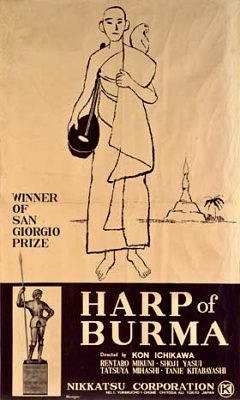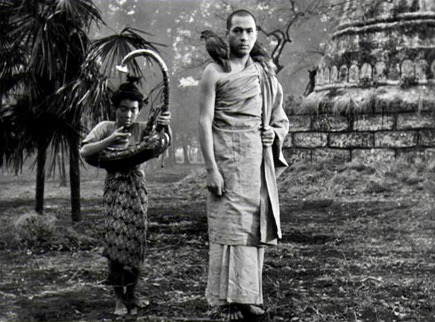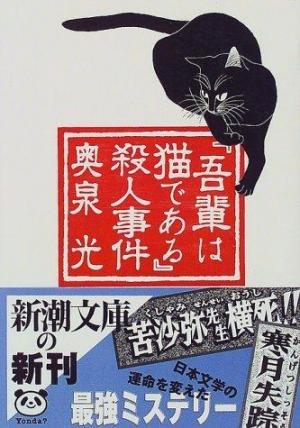In 1955 Kon Ichikawa was a well established filmmaker in Japan who was mostly known for satiric comedies like Mr. Pu (1953) and A Billionaire (1954) and the occasional literary adaptation like Young People (1952). His work was still unknown outside of his own country but that would change with his 27th film, The Burmese Harp (Japanese title: Biruma no tategoto, 1956). It would prove to be his first major critical and box office success in Japan but also one that would bring him international acclaim. “That was the first film I really felt I had to make,” Ichikawa later admitted to author and film scholar Donald Richie.
 Based on a popular 1946 Japanese novel by Takeyama Michio, the original novel offered a meditative and humanistic response to the psychological and emotional suffering the Japanese people had experienced in the war’s aftermath. Ichikawa was completely taken with the story but felt that it was closer, in style and tone, to a fairy tale for children. With the author’s permission, Ichikawa and screenwriter Natto Wada (Ichikawa’s wife), transformed Michio’s novel into a more realistic drama about the realities of war for soldiers on the front line in Burma.
Based on a popular 1946 Japanese novel by Takeyama Michio, the original novel offered a meditative and humanistic response to the psychological and emotional suffering the Japanese people had experienced in the war’s aftermath. Ichikawa was completely taken with the story but felt that it was closer, in style and tone, to a fairy tale for children. With the author’s permission, Ichikawa and screenwriter Natto Wada (Ichikawa’s wife), transformed Michio’s novel into a more realistic drama about the realities of war for soldiers on the front line in Burma.

Shoji Tasai plays Mizushima, a Japanese soldier whose wartime experiences send him on a spiritual journey in The Burmese Harp (1956).
Synopsis: Toward the end of World War II, a Japanese platoon in Burma surrenders to British forces and is placed in a prisoner-of-war camp until transport home can be arranged. Mizushima (Shoji Yasui), one of the most popular men in the regiment and an accomplished harp player, volunteers for a dangerous mission – to try and convince a garrison of Japanese soldiers holed up in a hillside cave to lay down their arms and surrender. The unit refuses and in the bloody battle that follows Mizushima is severely wounded. Nursed back to health by a monk, he experiences a spiritual transformation and takes to the road, disguised as a holy man, intent on honoring his dead comrades by giving their corpses a proper burial.

Mizushima (Shoji Yasui), a captured Japanese soldier, is ordered by a British officer to convince a Japanese squad to surrender in The Burmese Harp (1956), directed by Kon Ichikawa.
Takeyama’s original novel was told from the point of view of an unidentified soldier and prisoner of war who relates the curious tale of a company scout, Mizushima Yasuhiko, who disappears in the jungle and later re-emerges as a Burmese holy man. Ichikawa’s film splits the narrative into two stories; one which follows the journey of Mizushima’s character from soldier to pacifist and one which follows the fate of Mizushima’s regiment and commanding officer, Captain Inouye (Rentaro Mikuni). A sequence from the novel involving an encounter with cannibals was left out of the screenplay but the subject of starvation, disease, dementia and killing fellow Japanese soldiers for food in the final days of the war became the focus of Ichikawa’s other acknowledged masterpiece three years later, Fires on the Plains (Japanese title: Nobi, 1959).
The Burmese Harp remains unique for its lyrical qualities which provide a poignant but not overly sentimental contrast to the grim setting and circumstances. Unlike other anti-war films which can seem overstated or didactic, Ichikawa’s approach is more unexpected for the way it employs choral singing as a means to express thoughts and feelings not revealed in the conversations of the soldiers. As a result, the film becomes a deeply moving experience which is anchored by Shoji Yasui’s soulful performance in the role of Mizushima.
At the time Yasui was still considered a novice actor and had only appeared in two previous films. He had a kind and gentle nature but some physical adjustments were required for the part. Ichikawa said, “His shoulders were a bit of a problem because they were a bit fleshy. I asked him to lose a little weight since he was to play a starving soldier. He really conveyed the sincere nature of this character which was essential.”
Although Yasui would go on to appear in more than 30 films, he was better known in his own country for his stage roles and occasionally TV appearances. Japanese film buffs, however, will recognize him in supporting parts in such films as Rusty Knife (1958) and Masaki Kobayashi’s The Human Condition II: Road to Eternity (1959).

Captain Inouye (Rentaro Mikuni, center) leading his men in song in The Burmese Harp (1956), directed by Kon Ichikawa.
Rentaro Mikuni, who plays Mizushima’s commanding officer in the film and later became a director himself, recalled how much he learned from observing Ichikawa on The Burmese Harp. To achieve the mood he wanted, the director had the actors maintain a precise rhythm and sense of timing that was dictated by the storyboards he had created. He also made sure the actors memorized all the songs they would be singing because he was recording them on sync sound.

A scene from The Burmese Harp (1956) showing Japanese soldiers on the march in Burma in the WWII drama, The Burmese Harp (1956).
Mikuni had no trouble connecting with his character because he had experienced WWII firsthand and the frontline edict of kill or be killed. He later said in interviews that his army training often involved bayonet practice on live animals or prisoners-of-war which was the military’s way of hardening their recruits for battle.
Regarding the collaboration between Ichikawa and his wife Natto Wada, Mikuni noted, “In Natto’s script, the characters were precisely drawn and the lines were written in such a way as to work with the visuals to delineate each character…so she was very concerned with how Ichikawa shot it since she couldn’t tag along to the actual shooting. She made suggestions while watching the rushes….Just she and Ichikawa were in the [editing] room for hours. And there were always reshoots after she watched the rushes. It was an ordeal to maintain continuity in those reshoots.”
Certainly one of The Burmese Harp‘s most powerful and essential components was the music score by Akira Ifukube, who is probably most famous for “Godzilla’s Theme” which was first introduced in 1954 in Godzilla [Japanese title: Gojira]. Because Ifukube was a lifelong musician, composer and instructor (he later became president of the Tokyo College of Music), he had very set ideas about the score and he and Ichikawa would clash often over musical choices for the movie, particularly the distinctive sound of the harp that Mizushima plays (In truth, the harp was merely a prop, not a real instrument).
Mikuni would later comment that for the scenes in which he was leading his men in song, Ifukube would be standing next to the cameraman with a baton and the actor would mimic his movements. Among the selected choral numbers featured are “Hanyu no Yado,” the Japanese version of “Home Sweet Home,” the famous traditional “Song for the Close of School,” and Nippon tunes like “Kojo no Tsuki.”
Ichikawa said in an interview with Mark Shilling that, “Music is a very important element in films…if you want proof of how important music is, look at foreign films – the theme from The Third Man [1949] or The Bridge on the River Kwai [1957]. If those films hadn’t had that music what would they be like?…”Colonel Bogey’s March” in The Bridge on the River Kwai. When the soldiers whistled that song, it made the film. You could have never gotten the same emotions from that scene without that music.” And it must be said that Ichikawa’s use of music in The Burmese Harp is equally evocative and provides an emotional and spiritual balm for the psychic damage inflected on the soldiers by the war.
A huge success in its own country and throughout the world, The Burmese Harp was nominated for an Academy Award for Best Foreign Language Film but lost to Fellini’s La Strada. It also was awarded the San Giorgio Prize at the 17th International Venice Film Festival, the Lisbon International Film Festival Judges Special Award, a third place prize from the Tokyo Movie Press Association and a fifth place prize from Kinema Jumpo (Japan’s premiere film magazine).

Mizushima (Shoji Yasui) stands in front of a giant statue in Burma in Kon Ichikawa’s film The Burmese Harp (1956).
Although Ichikawa is best known outside his own country for his two anti-war epics, The Burmese Harp and Fires on the Plains, both of these movies were actually atypical of the director’s work which were contemporary dramas and satires about Japanese post-war society. Strangely enough, Ichikawa started out as a film animator, inspired by Walt Disney cartoons, but once he saw the films of Sadao Yamanaka, he became excited about the possibilities of live-action features. Among some of Ichikawa’s more famous and acclaimed films, many now available on DVD and Blu-ray in the U.S., are Odd Obsession [1959], Being Two Isn’t Easy [1962], An Actor’s Revenge [1963]), Tokyo Olympiad [1965] and I Am a Cat [1975].
The Burmese Harp was first released as a “roadshow” attraction in two parts in Japan with a running time of 143 minutes. Unfortunately, the film was edited down to 116 minutes for an export version and that is the only version in existence today.

Shoji Yasui stars in Kon Ichikawa’s The Burmese Harp (1956), Oscar nominee for Best Foreign Language Film.
In 1985, Ichikawa remade the film in color which had been his original plan back in 1955 but technical issues and budgetary concerns prevented that from happening. The 1985 version, with a running time of 133 minutes, was a commercial success in Japan but it was never released in the U.S. so it is hard to know whether it suffers in comparison to the original or is a worthy remake. If nothing else, Ichikawa got to return to a favorite story and theme but if you have never seen one of his films, the original 1956 version is a good place to start.  The Burmese Harp was released on DVD by the Criterion Collection in March 2007 with a few extra features such as new interviews with Kon Ichikawa and actor Rentaro Mikuni. In February 2012 the Masters of Cinema series from Eureka! In the U.K. released a Blu-ray edition which is now out of print. It is quite possible that Criterion will tackle a Blu-ray upgrade in the coming years.
The Burmese Harp was released on DVD by the Criterion Collection in March 2007 with a few extra features such as new interviews with Kon Ichikawa and actor Rentaro Mikuni. In February 2012 the Masters of Cinema series from Eureka! In the U.K. released a Blu-ray edition which is now out of print. It is quite possible that Criterion will tackle a Blu-ray upgrade in the coming years.  *This is a revised and expanded version of an article that originally appeared on the Turner Classic Movies website.
*This is a revised and expanded version of an article that originally appeared on the Turner Classic Movies website.
Other links of interest:
https://www.sensesofcinema.com/2004/great-directors/ichikawa/
https://www.theguardian.com/film/2008/feb/14/obituaries.japan
https://www.youtube.com/watch?v=_bw8SgZuaO0










